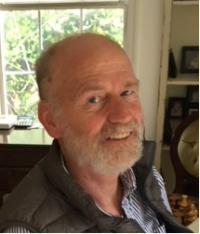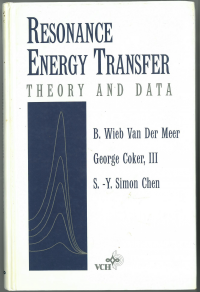VanDerMeer B. Wieb
B. Wieb VanDerMeer
born April 7, 1950, the Netherlands. Ph. D. in Theoretical Physics, 1979 from the University of Groningen. My thesis was on liquid crystals. During 1975-1979 I did research in this field and found out that the human body is loaded with liquid crystals as membranes, myelin, white brain matter and other organs/organelles. This aspect of liquid crystals was not part of my work, but it intrigued me and I applied to the Netherlands Cancer Foundation allowing me to switch to molecular biophysics. This switch was my first culture shock, which was extremely heavy. The one I underwent in 1986 by moving to the USA was light in comparison. The 1986-culture-shock was adapting to American society which was not that hard for my family and me, but in 1979 I needed to learn that the purely mathematical approach to science did not work for me anymore until I learned more biochemistry, fluorescence, and less mathematical ways of communicating science. I did a post-doc at the University of Leyden, where Jaap de Goede, Bert Verveen and Dick Ypey taught me molecular biophysics and physiology. I collaborated with Wim van Blitterswijk and Rob van Hoeven who taught me membrane fluidity and fluorescence depolarization. I joined them at the Netherlands Cancer Institute in Amsterdam, where I did my second post-doc. I was a visiting scientist for a few month in 1983 working with Enrico Gratton at the University of Illinois in Urbana-Champaign. Enrico taught me more fluorescence and multi-frequency fluorimetry. In 1985 I joined Dave Jameson and Moshe Levi in Dallas, Texas, where I learned more fluorescence from Dave and more biochemistry from Moshe. After 2 years at the Oklahoma Medical Research Foundation where Peter Sims introduced me to excimer fluorescence and immunology, I joined the department of Physics and Astronomy at Western Kentucky University in 1988, as an assistant professor. I am still there now (2017) as a full professor, teaching physics and biophysics, and doing research in FRET (Fluorescence with Resonance Energy transfer, a.k.a. Förster Resonance Energy Transfer). In the early 1990’s I noticed that the information about Förster distances was scattered all over the literature and only a few tables had been collected. I decided that gathering these distances in tables should be very useful and my student, George Coker, and post-doc, Simon Chen, and I did that and were planning to publish the tables as an article or review paper somewhere, but then Elisha Haas suggested we should write a book. I was knowledgeable about FRET but certainly not an authority. However, by preparing the book I became an expert. I now believe that one should focus on the top-cited papers in an area, and thoroughly study those to facilitate the transition from user to expert. I did that and wrote with George Coker and Simon Chen “Resonance Energy Transfer” as FRET was called then. I learned to love all aspects of FRET but in particular the orientation factor, kappa-squared, which is hated by many FRET people, unfortunately. Bob Dale taught me a lot about kappa-squared. I have enjoyed collaborating with many people, notably among them are Steve Vogel, who pointed out the importance of kappa-squared in the static averaging regime, and Paul Blank, who showed me that fitting time-resolved-efficiency data is useful, but tricky.
Selected Publications
- Van Blitterswijk, W. J., R. P. Van Hoeven, and B. W. Van der Meer. "Lipid structural order parameters (reciprocal of fluidity) in biomembranes derived from steady-state fluorescence polarization measurements." Biochimica et Biophysica Acta (BBA)-Biomembranes 644, no. 2 (1981): 323-332.
- van der Meer, B. Wieb, Robert P. van Hoeven, and Wim J. van Blitterswijk. "Steady-state fluorescence polarization data in membranes. Resolution into physical parameters by an extended Perrin equation for restricted rotation of fluorophores." Biochimica et Biophysica Acta (BBA)-Biomembranes 854, no. 1 (1986): 38-44.
- Van der Meer, B. W., M. A. Raymer, S. L. Wagoner, R. L. Hackney, J. M. Beechem, and E. Gratton. "Designing matrix models for fluorescence energy transfer between moving donors and acceptors." Biophysical journal 64, no. 4 (1993): 1243-1263.
- Van Der Meer, B. Wieb, George Coker, and S-Y. Simon Chen. Resonance energy transfer: theory and data. New York: VCH, 1994.
- Van der Meer, B. W. "Kappa-squared: from nuisance to new sense." Reviews in Molecular Biotechnology 82, no. 3 (2002): 181-196.
- van der Meer, B. Wieb. "Förster theory." FRET-Förster Resonance Energy Transfer: From Theory to Applications (2014): 23-62.
- Byrne, A.G.1, Byrne, M.M.1, Coker, G.III1, Gemmill, K.B.2, Medintz, I.L.2, Sloan, S.L.1, Spillmann, C.2, and B.W. VandDerMeer.1 Data, Chapter 14, in “FRET: Förster Resonance Energy Transfer: From Theory to Applications”, editors: I. Mediintz and N. Hildebrandt, Wiley-VCH Verlag GmbH & Co. KGaA, 2014.
- B.W. VandDerMeer, D. M. van der Meer, and S.S. Vogel: Optimizing the Orientation Factor Kappa-Squared for More Accurate FRET Measurements, Chapter 4, in “FRET: Förster Resonance Energy Transfer: From Theory to Applications”, editors: I. Mediintz and N. Hildebrandt, Wiley-VCH Verlag GmbH & Co. KGaA, 2014.
- Vogel, Steven S., Tuan A. Nguyen, B. Wieb van der Meer, and Paul S. Blank. "The impact of heterogeneity and dark acceptor states on FRET: implications for using fluorescent protein donors and acceptors." PloS one 7, no. 11 (2012): e49593.
- Vogel, Steven S., B. Wieb van der Meer, and Paul S. Blank. "Estimating the distance separating fluorescent protein FRET pairs." Methods 66, no. 2 (2014): 131-138.

